Polypropylene-Random (PP-R) Piping Systems Serve Multiple Applications
Durable, corrosion-free, versatile and environmentally friendly, engineered PP-R piping can also reduce installation time
![]() Continuing Education
Continuing Education
Use the following learning objectives to focus your study while reading this month’s Continuing Education article.
Learning Objectives - After reading this article, you will be able to:
- Summarize the unique features and benefits of polypropylene-random PP-R) piping for pressure systems.
- Evaluate the different types of PP-R piping and their applications.
- Identify design issues to be considered while planning PP-R piping systems.
- Discuss the unique features and methods required for efficient installation.
Piping systems are an integral part of virtually every building from residential towers and manufacturing facilities to hotels, data centers and healthcare centers. Since pipe failure can result in costly repairs and replacements, potential health hazards and significant environmental impact, appropriate pipe selection is a critical decision.
For the past 200 years, pipe materials have ranged from cast iron, steel and concrete to copper and polyvinyl chloride (PVC). For the last decade, engineers in North America have been given a new option: engineered polypropylene-random (PP-R.) Now installed in multiple projects across the U.S. and used throughout Europe for the past 40-plus years, PP-R has multiple benefits. It is one of the longest lasting and most chemically inert piping materials in the world.
Corrosion-resistant, chemically safe, sustainable and reliable, with an insulation value, PP-R is also code compliant, cost effective and can be integrated with other pipe materials such as copper and steel. Its applications include potable water, heating and cooling distribution (hydronic), condenser water, industrial and chemical process applications, water conservation and fire sprinkler systems.
What is PP-R?
Manufactured from polypropylene-random polymer, PP-R is a thermoplastic made up of chains of carbon and hydrogen. It is both simple and chemically stable and does not contain harmful chemicals or react with its surroundings. The “R” in PP-R refers to the random blend of long and short hydrocarbon chains that provides both rigidity and flexibility, resulting in a material with strong structural properties that can still bend enough to absorb impact and deflection. As a hydrophobic material, meaning that it repels polarized molecules like H2O, PP-R does not interact with water. It does not corrode, is very erosion-resistant even in slurry applications, and will not leach, wear out or clog up after a few years of service. Even hard water will not affect PP-R.
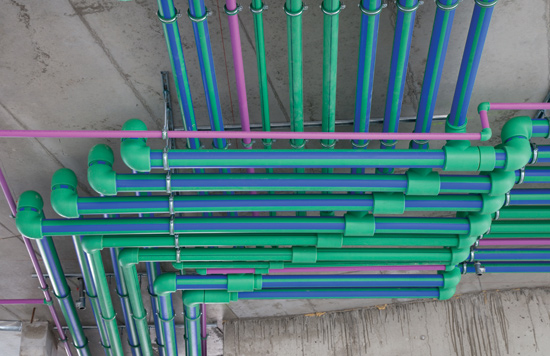
Photo courtesy of Aquatherm
Engineered polypropylene-random (PP-R) pipe is used for a variety of applications in North America.
PP-R has natural insulation properties that reduce and dampen noise created by water flow and water hammer. The strong bonds created by thermal fusing allows the pipe to absorb the shock and force from pressure surges and water hammer without the need for water hammer arrestors or thrust blocking.
Some pipe manufacturers develop and blend their own proprietary PP-R material for different pipe applications. Some of these product offerings are also heat-stabilized to protect the pipe from long-term exposure to temperatures that would damage other plastics.
PP-R pipe and fittings are fully recyclable, which allows any scrap material to be diverted away from the landfill.
Recycled pipe can be ground, melted and re-used in car parts, home products, food packaging and other applications. There are no harmful waste products created by the processing or disposal of PP-R.
To facilitate integration with other systems such as copper, steel and cross-linked polyethylene (PEX), a wide range of transition fittings are available. These transitions include threaded adapters, PEX adapters, copper stub-outs, flanges and groove adapters.
Heat Fusion
PP-R connections are mostly made through heat welding or heat fusion without any adhesives, solvents, solder or mechanical connections. Two similar plastics are simultaneously heated to a “melt” state and allowed to cool together under pressure. As the PP-R molecules cool, they bind with each other and turn into one piece, the way they would during extrusion or molding. Different styles of PP-R heat fusion include socket fusion, outlet fusion and butt welding. Another style is electrofusion, a means of heat fusing pipe and fitting in tight spaces. It is mainly for retrofits or instances where other irons will not fit. It is more expensive and is more of a tight-space solution than a go-to method.
The result is a seamless bond between the materials that possesses the same qualities as the original material and takes from a few seconds on smaller sizes to a few minutes on larger diameters to achieve, with no adhesives, solvents, solder or mechanical connections. The fused material has the same strength as the pipe wall, so there is no path for leaks or blowouts. This provides a certain level of flexibility in the assembled pipe that makes it easy to prefabricate and move on-site without the risk of the joints cracking and leaking. This flexibility and homogeneous joint region also allows for a wider range of applications and protects the pipe from seismic stresses.
For installations with branch lines, fusion outlets offer many advantages over traditional reducing tees. They generate less friction, thus lowering the pressure loss of the entire system.
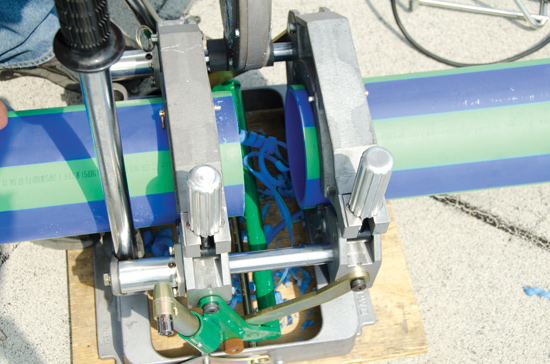
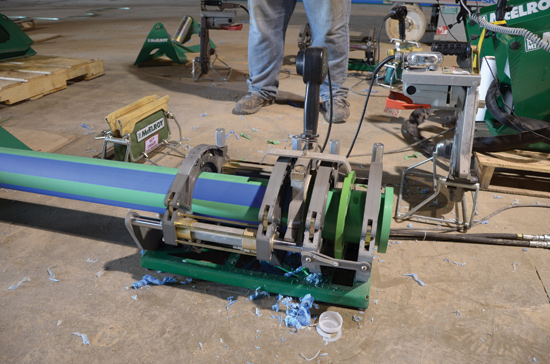
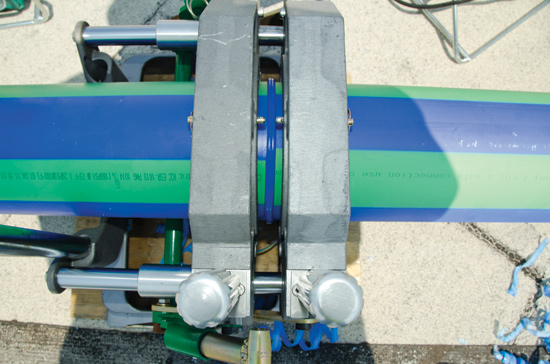
Photos courtesy of McElroy Manufacturing
The butt fusion process requires shaving the faces off the ends of the pipe so they can be properly connected, introducing a heating iron to melt the pipe and then pressing them together, resulting in a permanent bond.
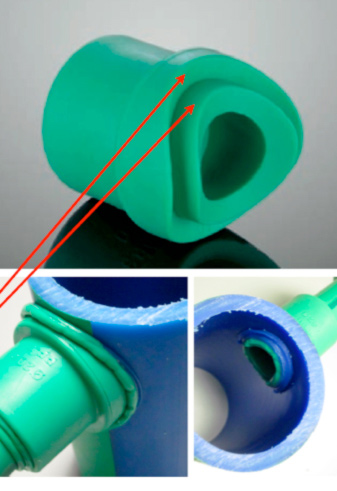
Photos courtesy of Aquatherm
PP-R heat fusion outlets are joined on the O.D. of the tube as well as through the thickness of the sidewall (red arrows).
Standard Dimension Ratio
Standard dimension ratio (SDR) is the ratio of the outside pipe diameter to its wall thickness and is used as a method for rating a pipe's durability against pressure. A high SDR ratio indicates that the pipe wall is thinner compared to the pipe diameter, resulting in lower pressure rating. A lower SDR indicates that the pipe wall is heavier, resulting in a higher pressure rating.
In North America, fusible plastics used for pressure piping, including PP-R, are typically manufactured according to SDR dimensions as specified in ASTM International standards. All pipe sizes in a given SDR have the same pressure ratings. The ratings do not decrease with larger size SDR pipes as they do with schedule or type-based pipe commonly used in North America such as steel and copper.
In some cases, PP-R and other fusible plastics are made to schedule sizes. These are typically either non-pressure drainage products or specialty chemical process piping. In most of these cases, there are different ASTM designations to differentiate the products, such as ASTM F1412 for corrosive (acid) waste piping. The standard for PP-R pressure piping used in mechanical and plumbing system is ASTM F2389. Additionally, for potable water systems, the piping must comply with NSF 61 and the oxidative resistance testing of ASTM F2389. In North America, there are several manufacturers with listings per ASTM F2389 for mechanical applications, and one manufacturer has a listing for NSF 61 and oxidative resistance for potable water.
SDR is one of the major factors used in engineering pipe systems for a specific application, where each SDR has its own advantage. For instance, a heavy wall pipe with an SDR of 7.4 could be specified for high-stress applications such as hot water recirculation that requires increased pressure and temperature ratings, while a thinner wall pipe with an SDR of 17.6 would provide maximum flow rate while minimizing material weight, cost and fusion time. PP-R pipe manufacturers list SDRs and their appropriate application.

Images courtesy of Aquatherm
Examples of pipe SDRs.
Left: A thicker wall provides increased pressure and temperature ratings for high-stress applications such as hot water recirculation.
Middle: A medium wall thickness provides higher flow rates while maintaining high pressures and is suitable for most mechanical and industrial applications.
Right: A thinner wall allows maximum flow rate while minimizing material weight, cost and fusion times and is used for chilled, cooling and condenser applications.
Multilayer Faser (MF) Technology
In order to increase maximum operating temperatures, a leading manufacturer has developed a multilayer faser (MF) technology process. The result is an extruded middle layer in the pipe that is a mixture of glass fibers and resin that allows the pipe to remain rigid at higher temperatures and significantly reduce thermal expansion. This multilayer faser product does not require any modification to the fusion process. Nor does the low concentration of glass fibers in the pipe interfere with the fusion process or the recycling process. In some cases, the glass-fiber reinforced PP may be sorted for recycling separately from non-reinforced PP.
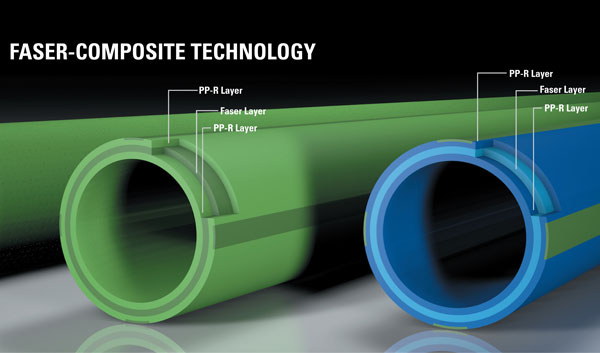
Image courtesy of Aquatherm
Typical examples of multilayer faser layers that control PP-R pipe expansion.
With multilayer faser (MF) technology, PP-R pipes have thermal expansion properties comparable to metal pipe. The PP-R material can absorb the stresses created due to thermal expansion, and as such can be controlled much more readily than similar piping layouts using metal. PP-R pipes can be buried without any expansion controls or thrust blocking restraints (supports at the joints), as the weight of the soil will restrict any movement. Anchors may be required at certain locations to ensure no movement of the pipe, such as lateral movement where the pipe enters a building foundation.
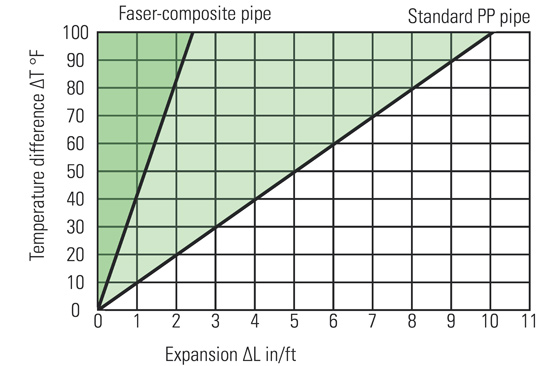
Chart courtesy of Aquatherm
Compared with standard plastic pipe, multilayer faser pipe has significantly lower linear expansion.
Additional advantages of using MF technology is that it maintains a higher internal pipe diameter—consequently a higher SDR than an equivalent non-MF pipe—which allows a higher flow rate; requires fewer supports because the pipe is more rigid; and has less weight than metal pipe.
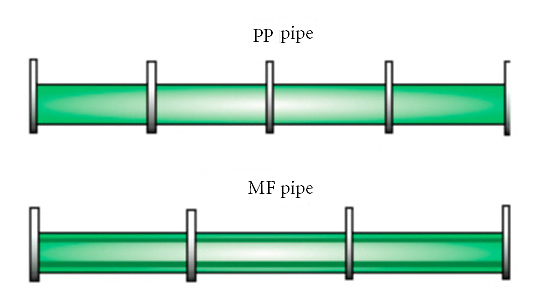
Image courtesy of Aquatherm
Compared with standard PP-R, PP-R pipe with multilayer faser technology requires fewer supports.
Types of PP-R
Manufacturers have developed several lines of pipe that are specifically engineered for certain applications and have identified them with colors and stripes.
While there have been some standards and piping codes issued that specify pipe colors, in most cases these only apply to the marking on the pipe (e.g. potable water pipe may be required to have white marking on a green background). This marking can be achieved in a variety of ways and does not affect the color of the pipe itself. Within the plastic piping industry, the color purple is used to identify reclaimed/recycled water, and yellow is used for natural gas. Beyond this, colors can vary significantly between manufacturers. Design professionals and contractors should confirm each manufacturer's product color designations before relying on this to differentiate a pipe system.
In some cases, there may be more than one manufacturer using a specific color for a specific application. To ensure a product is being used properly, the design professional must also consult the manufacturer and the various product approvals and listings.
PP-R pipes are used for potable and food grade applications, hydronic, gray water and industrial systems. They are also used for light-hazard fire sprinkler, geothermal and other systems.
For purposes of clarification in this CEU, PP-R green pipe refers to pipes used for potable and food grade applications; PP-R blue pipe refers to medium-thick pipe used for hydronic and industrial applications.

Photo courtesy of Aquatherm
Green PP-R pipe with molded PP-R heat-fused fittings is approved for potable water.
Potable Water Green Piping
Since it is free of heavy metals and toxic chemicals, one manufacturer's PP-R pipe has been tested and listed for compliance with ASTM F2389, NSF 61 and NSF 372, providing a safe option for potable water systems required for drinking water. For food processing, listing to NSF 51 is required. Unlike other piping materials that may allow trace amounts of chemicals to be pulled from the pipe walls or joints into the water, hydrophobic polypropylene green pipe prevents leaching.
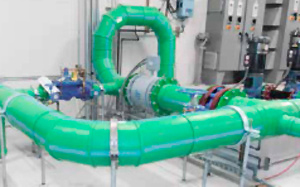
Photo courtesy of Aquatherm
An Alaskan correctional facility used PP-R piping in sizes ranging from ½-in. to 12-in.-dia for: potable, water treatment, wastewater, hydronic and compressed air systems.
One leading manufacturer has developed resin that is 97 percent pure polypropylene-random, with less than 3 percent additives. The additives include green pigmentation for opacity to prevent microbiological growth, ion deactivators (to protect the PP-R from free metal ions) and heat stabilizers. Heat stabilizers protect the PP-R from short-term exposure to high temperatures (200+°F) in the event of equipment malfunction as well as long-term exposure to rated elevated temperatures. This particular pipe product can also be used for multipurpose residential sprinkler applications (per NFPA 13D) and is available with UV protection for outdoor installations and multilayer faser technology, which reduces linear expansion. The manufacturer offers over 400 fittings, transitions and valves, for installation in a variety of systems.
One manufacturer's PP-R green pipe is code approved for potable water (NSF 61) and direct food contact and food processing up to 212°F (NSF 51), IPC, UPC, NFPA, FM and is in accordance with CSA B137.11.
While it could be used for virtually all of the systems being discussed, green PP-R pipe is best suited for the following applications for which it is designed:
Potable water. Approved for direct contact with food and potable water and can be used as the distribution main system in hospitals, schools, high-rise buildings, hotels, shipbuilding, sports facilities, residences and many other projects.
Compressed air systems. With a thicker-walled SDR (e.g., 7.4) green pipe PP-R can offer superior pressure ratings and resistance to shattering. Additionally, because PP-R piping systems do not corrode, attached equipment is protected from rust and debris.
Multipurpose fire sprinklers (NFPA 13D). For one- and two-family dwelling occupancies, green pipe can be integrated with the potable water system to provide fire protection. The high flow rates allow for mains and branches to be run through the building rather than through many individual pipes, keeping the system simple and efficient.
Marine applications. Because green pipe is made from hydrophobic, low-friction material it is unaffected by the dissolved minerals contained in seawater, freshwater and brine.
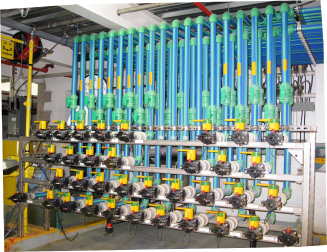
Photo courtesy of Aquatherm
At a Midwestern paper mill, more than 19,000 ft of PP-R pipe, connected by roughly 4,250 fittings and valves, provided a single-material solution.
Medium-Thick Blue Piping for Hydronics and Industrial Applications
For applications that do not require potable ratings, blue PP-R piping is engineered with heat stabilization and can serve as a tougher, longer-lasting alternative to steel, stainless steel and some plastics for heating, cooling and industrial applications. It offers higher volumetric flow rates due to thinner walls, and with MF, the same improvement in thermal expansion compared to non-reinforced plastics. While other piping materials lose performance over time to scaling and corrosion, this engineered PP-R material can resist any form of change to the material wall, and is resistant to impact and seismic stresses.
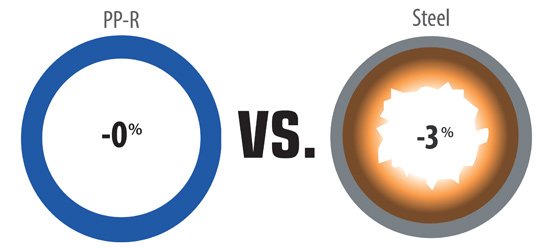
Image courtesy of Aquatherm
Corrosion and scaling can reduce the inside of steel pipes by an average of 3 percent per year.
Even after decades of use, PP-R pipe has been found to retain its original flow characteristics. This prevents the loss of efficiency that occurs from scaling and corrosion when using a pipe that can scale or corrode and will save energy over the life of the system. Corrosion and scaling can reduce the inside of steel pipes by an average of 3 percent per year, resulting in lost efficiency and up to 10 percent increased pumping energy annually. This can add up to thousands of dollars in hidden energy costs over the life of the system.
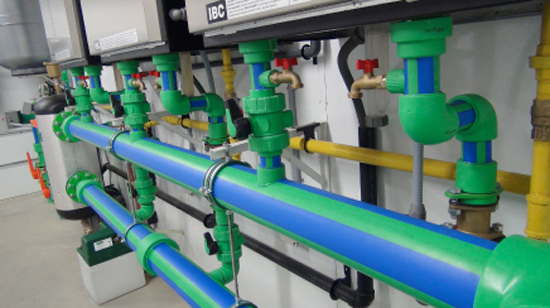
Photo courtesy of Aquatherm
High-capacity manifold systems using engineered PP-R with multilayer faser technology can be used for heating distribution.
Heating distribution. For commercial, industrial and residential use, engineered PP-R with multilayer faser (MF) can be specified due to its reduced linear expansion, resistance to corrosion and toughness—thus increasing performance and extending the service life of the system. In addition, no chemical treatments are needed for protection. This again saves maintenance costs and reduces waste. Keep in mind, however, that some lower level of chemical treatment may still be needed for metal components in the system.
Small-diameter non-MF coils are available for use in snow-melt applications in soil, concrete or asphalt.
Chilled water distribution. For residential, commercial and industrial use, engineered PP-R pipe has a natural insulation value (estimated 1 or more per inch of pipe wall) that helps reduce heat gain and can eliminate problems with condensation in some cases where metal pipe would require insulation, making it a suitable choice for domestic cold water, cooling towers and condenser water.
Industrial applications. Both green pipe and blue PP-R pipe can be safely used in light industry, heavy industry, automotive mechanic shops and more. Given its resistance to many types of chemicals, PP-R is an appropriate choice for the processing and transport of many aggressive mediums and materials.
Compressed air systems. Both SDR 7.4 PP-R and SDR 11 PP-R piping are used in light or heavy industry, automotive, manufacturing, aviation and other compressed air application in systems.

Photo courtesy of Aquatherm
Longevity and absence of leaks and corrosion make PP-R piping suitable for athletic field and in-floor heating systems.
Snow-melt, turf-warming, in-floor heating systems. With its heat-fused connections, low-pressure drops and extended length tubing coils, PP-R can make a safe and efficient installation under most surfaces, from asphalt and concrete to artificial turf and real grass. Using fusion outlets allows for an extended manifold layout, which helps reduce costs and improve performance.

Photo courtesy of Aquatherm
PP-R pipe can be used in geothermal applications, allowing for horizontal storage of the geothermal mass as opposed to deep vertical wells.
Geothermal. As noted above, all engineered PP-R pipe can typically be safely buried in soil, sand or concrete. Some PP-R pipes are used in horizontal grids for geothermal applications, thereby storing the geothermal mass horizontally instead of in deep vertical wells.
Piping for Water Conservation and Gray Water Systems
Water conservation (catchment, reclaim, re-use) systems are being specified and installed much more frequently in certain areas of the continent, as building and plumbing codes are updated to encourage more responsible water use. Most codes require that these systems be kept entirely separate from the potable water supply and that the piping be color coded and labeled to identify it as non-potable. PP-R pipe with distinctive purple coloring is suited for this non-potable application (which often involves very aggressive water) due to its resistance to corrosion, scaling and microbiological growth. The water from reclaimed, recycled and rainwater sources can be used for flushing, irrigation, cleaning and other non-potable applications.
Purple pipe designed exclusively for these applications uses the same PP-R material as used for potable and hydronic applications described above, with the addition of design modifications, coloring, marking and independent third-party certification by NSF International (14).


Photos courtesy of Aquatherm
PP-R purple pipe is used for recycled, reclaimed and rainwater applications.
Design Considerations
When designing with PP-R piping systems, it is important to be aware of their unique features such as multilayer faser (MF) for expansion control, proper SDR selection, fusion connections, impact and chemical resistance and sound insulation.
Determining Compatibility
The first step is to verify that PP-R is an acceptable material choice for a particular application. While PP-R pipes are suited to a wide variety of applications, they still have chemical, pressure and temperature considerations that need to be addressed in order to limit the risk of a leak. Operating outside of the safety parameters provided by the manufacturer can shorten the life of the pipe. By bringing a system's intended use in line with the application parameters given in manufacturer documents, engineers can ensure that the pipes will last for many decades.
Suitability. Steam systems, gas systems, water systems with both high temperature and pressure, or systems with high levels of certain aggressive chemicals will likely not be suitable for use with PP-R. Manufacturers offer evaluation for suitability and will confirm which, if any, of the products is suitable for the intended end-use.
In some applications, PP-R pipe may not last as long as it would in a typical plumbing or heating installation, but may still outlast other piping alternatives. Some manufacturers will provide guidance on these applications and performance expectations in these more stringent environments.
Choosing Your System
Although PP-R types share similar characteristics, they are also engineered for use in certain applications. Choosing the correct system for the application will maximize performance and minimize material costs.
As a general rule, green pipe should be used for potable and food-grade applications, while medium-thick blue pipe is used for heating and cooling, compressed air, and a variety of industrial applications. Purple pipe is intended for use in water conservation and gray water systems.
Only multilayer faser pipes should be used on heated or chilled applications, in order to reduce linear expansion.
One manufacturer recommends using the thinnest walled pipe that will meet the temperature and pressure ratings required by the system. Manufacturers' recommended operating parameters typically contain a significant safety factor.
Determining Efficiency
The natural R-value and reduced friction factors are especially important because they reduce the amount of energy needed for the system to perform. With careful planning and engineering, it is possible to exceed existing performance standards and maximize a system's efficiency.
PP-R pipes have a high flow coefficient, and do not suffer from a loss of flow over time due to corrosion. However, for some products the differences in the inside diameter will necessitate flow calculations be made specifically for the PP-R pipe selected. Information regarding flow rates, flow velocity and head loss through fittings can be supplied by the manufacturer.
Integrating With Other Systems
When integrating PP-R piping systems with other systems, it is important to ensure that the operating parameters for PP-R won't damage the other materials or vice versa. Be aware that even if the PP-R pipe is compatible with the chemical being transported, other materials in the system may not be. Make sure that all parts of the system are compatible with the medium being carried before installing them. While PP-R pipe does not require treatment to protect it from corrosion, ferrous metals in the system will. Do not mix PP-R pipe with other piping systems in conditions that will cause the other system to fail.
When there is extensive use of copper piping in conjunction with PP-R, care should be taken to ensure the operating conditions will not cause dissolution or corrosion of the copper. Manufacturers recommend following the Copper Development Association's guidelines for sizing, temperature and flow speed in systems using both copper and PP-R pipe. Copper pipe/tubing should not be used in recirculating domestic hot water systems with PP-R piping.
Planning
All fusion connections require a certain amount of space and mobility around each joint. The amount of space needed for a fusion machine to operate varies by manufacturer and machine type. It is best to confirm that there will be enough space for a machine to operate when planning the installation.
Flame Spread/Smoke
PP-R piping systems do not produce toxic by-products during combustion. In a fully developed fire, PP-R will produce carbon dioxide gas and water vapor. In an under-developed fire, trace amounts of carbon monoxide may be produced, but this is common in all combustible materials including wood and paper. Many building codes do not consider the toxicity of the smoke produced but focus only on the volume and opacity of the smoke. Therefore, it is important to install only pipe that meets local code requirements.
For highly rigorous code requirements, engineers are advised to consult manufacturers for code compliant PP-R solutions.
Plenum Space
When installing PP-R in a plenum space, special considerations need to be taken to meet building codes for flame and smoke limitations. Information regarding plenum-rated options can be found in manufacturers' literature.
Outside Installation
When installed outdoors, with direct sunlight exposure, PP-R pipe will need to be protected from UV radiation since UV radiation can damage and weaken the polypropylene chains over time. Manufacturers can offer guidance on protection solutions such as wraps and paints.
Thrust Blocking
Due to the inherent strength and integrity of fused connections, thrust blocking is not required. Anchors may still be necessary where buried pipe enters a building foundation or other locations to minimize pipe movement.
Fire Stopping
Polypropylene is a combustible material and must be treated as such. Generally, when penetrating a fire-rated assembly, fire stopping must be used to give the penetration a fire rating that matches the rating of the assembly.
It is critical that fire stopping issues be addressed early in the design and construction of a project. Consult with a PP-R producer for a current list of manufacturers who have tested and listed their products for use with PP-R piping systems.
System protection. Allowing a pump to operate for an extended period with zero flow can result in temperatures beyond those recommended. Engineers are advised to provide a sensor system that will warn of temperatures over 180°F, an automatic temperature and pressure relief valve at the pump discharge, or a similar preventative measure.
Vibration Isolation
PP-R can absorb small vibrations, so isolators are not required if the pipe has some limited mobility on either side of the pump. PP-R pipe flowing at 10 ft/s generates less noise than copper pipe flowing at 5 ft/s.
Noise and Water Hammer
To avoid noise generation and water hammer, the flow rate should not exceed 10 ft/s. Buried pipe or piping in industrial applications may run up to 12 ft/s or higher, depending on the manufacturer's recommendations, as noise generation is typically not an issue.
LEED®
Upgrading to PP-R piping systems can contribute to LEED credits in several categories. One leading manufacturer has published a practical guide based on Version 3.0 for New Construction and Major Renovations for applying PP-R piping systems to the LEED credits program. As a starting point, it focuses on major strategies that address several credits at once, earning a number of points by implementing one large innovation. This would also be applicable to the recently published, but not yet implemented, LEED v4.
Installation
Ease and speed of installation is one of the biggest cost savers that results from using the innovative technologies and advantages of PP-R piping. But heat fusion connections and outlets, lightweight material, resilient, slightly flexible pipe and connections and reduced expansion and contraction are all technologies that require a different mindset from those familiar with metal or even other plastic systems.
Training
Manufacturers offer training courses and detailed manuals to prepare installers for using PP-R.
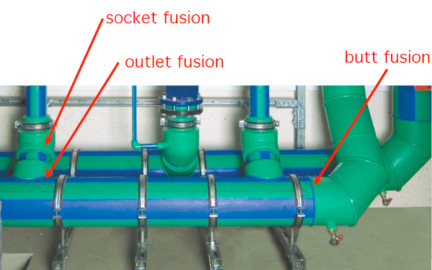
Image courtesy of Aquatherm
On-site heat fusion connections do not weaken the structure of the pipe and may be placed closer together than other branch-type connections.
Tooling
Fusion tools are a critical component of a PP-R installation. Installers should ensure they have optimal tools for each type of connection. Duplicate tools can speed installation, and the cost of rented or purchased tools can often be offset by increased efficiency.
Lightweight Material
Piping weighs 75 percent to 80 percent less than comparable metals, which means that installers can do more in-shop or onsite fabrication and move the piping with less fatigue and less risk of injury.
Comparatively Fast Connection Times
Heat fusion can save over 30 percent on labor time compared to traditional welding and soldering and is comparable to the quickest labor-saving connection methods.
Prefabrication
Some manufacturers offer in-house fabrication for manifolds and complex assemblies.
On-Site Fabrication
Since polypropylene is lighter than other piping materials, fusion joints adjust to reasonable levels of stress from being carried around. To take advantage of this, many installers set up prefab stations.
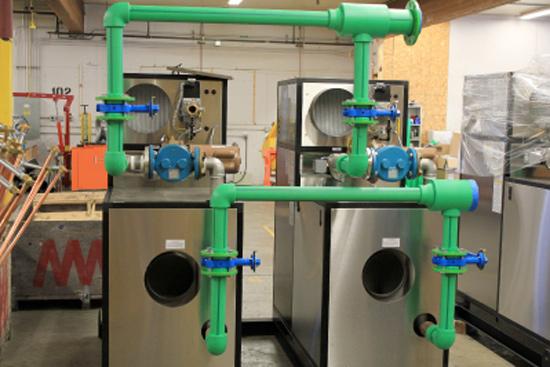
Photo courtesy of Aquatherm
These boiler skids were prefabricated in a major contractor’s shop, and then flown to the building’s roof by helicopter, saving considerable labor costs.
Supporting the Pipe
Installers should base hanger spacing on the intended operating temperature of the pipes, taking into account the temperature differential between the internal fluid and external ambient conditions. Manufacturers provide support interval tables.
Linear Expansion
This depends on the difference between installation temperature and operating temperatures. Again, manufacturers provide calculation tables as well as online tools for doing thermal expansion calculations and determining compensation for this.

Photo courtesy of Aquatherm
PP-R transition fittings allow PP-R pipe in systems that also use copper, PEX, steel and other piping materials.
Transition Fittings
Fittings for transition to steel, copper, PEX and to larger sizes of pipe are available. Transition elements with brass inserts are not suitable for all media. For corrosive applications, use connections and valves that are strictly polypropylene or stainless steel. The product manufacturer will provide guidance on whether fittings with metal inserts can be used in a given application. Brass transitions for use in potable water applications must comply with the zero-lead requirements, such as NSF 372.
Conclusion
Polypropylene-random piping (PP-R) for pressure systems has been successfully installed in thousands of projects in North America and Europe. Its benefits include durability, resistance to corrosion and ease of installation. It does not leach harmful chemicals, is code compliant, cost effective, sustainable and can contribute to LEED points. PP-R technology requires a different mindset from those familiar with metal or even other plastic systems. But contractors report that after an initial learning curve, installation is easier and faster than with other systems.
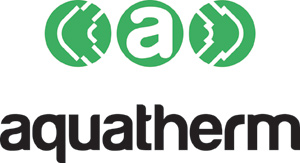 |
Made from fully recyclable polypropylene-random (PP-R), Aquatherm’s highly engineered pipe systems deliver an environmentally friendly alternative to metal and plastic pipe for plumbing, HVAC and industrial applications. Aquatherm can handle 180°F water, yet doesn’t rust, corrode or leach. The simple heat fusion connection eliminates leak paths and is so reliable it comes with a 10-year multimillion-dollar warranty. www.aquatherm.com |



